Table of contents
- Guide: Adjusting the suspension / damping correctly, part 1 Adjust the suspension on the motorcycle
- Basic function of the spring preload: on the fork
- Basic function of the spring preload: On the shock absorber
- Videos: expert tips
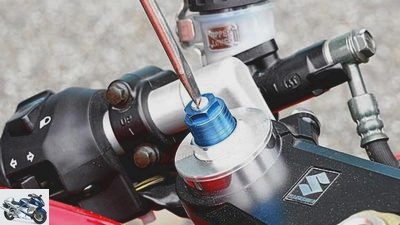
Photos: fact
accesories
landing gear & Spring elements
Adjusting suspension / damping correctly, part 1
Guide: Adjusting the suspension / damping correctly, part 1
Adjust the suspension on the motorcycle
Anyone who makes targeted use of the adjustment options on motorcycle chassis can adapt the driving behavior to their individual wishes. But to do this, it is necessary to understand the basic functions of suspension and damping.
Werner Koch
04/14/2011
Why, so many motorcyclists ask, should one get lost in the seemingly impenetrable jungle of damping clicks and spring adjustments when the motorcycle is actually driving reasonably well? The answer is simple: Because with a correctly tuned suspension system it drives even better, is even more fun and, under certain circumstances, active safety is also improved.
In order to see whether the spring elements are within the tolerance range, the so-called spring base is measured in step number one, which can be adjusted using the spring preload options. This spring base ensures that the machine is in the position that the designer intended for the steering and frame geometry.
Buy complete article
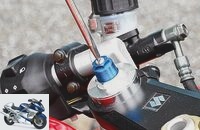
Guide: Adjusting the suspension / damping correctly, part 1
Adjust the suspension on the motorcycle
3 pages) as PDF
€ 2.00
Buy now
The balance between maneuverability and driving stability is only guaranteed if the steering head angle and the related caster of the front wheel are correctly positioned. In addition, the swing arm, depending on the spring preload on the shock absorber, must also be at the correct angle to the horizontal. If the swing arm is too flat, the motorcycle dips too much at the rear when accelerating, which means that the spring comfort and handiness deteriorate because the anti-dive effect on the rear wheel is too low. In addition, the spring base on the rear wheel also influences the steering geometry.
The negative suspension travel is measured under two load conditions. Negative spring deflection one (short: N1) results from the weight of the motorcycle in an absolutely vertical position. Negative suspension travel two (N2 for short) results from the weight of the motorcycle plus the driver in an upright sitting position.
The difference between the two values shows whether the spring used (technical jargon: spring rate) is too hard (small difference) or too soft (large difference), depending on the driver’s weight. Example on the fork: With N1 with 25 millimeters and N2 with 45 millimeters, the spring would be too soft and should be replaced by a harder one. The values do not apply to adjustments for racing machines or for chassis suitable for the racetrack.
Very important when making changes to the chassis: Always follow the information in the driver’s manual first. Just take one step at a time and try out the effects on driving behavior on a route you are familiar with: whether you feel a change in driving behavior, whether you feel comfortable and whether the motorcycle can be maneuvered the way you want it to be.
If you are not satisfied with the setting, go back to the standard setting and try another way to get the desired result. Finally, the setting options for the hydraulic damping offer one or the other option for optimizing the chassis.
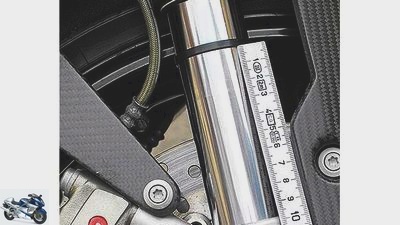
Cook
Load the motorcycle without a rider, measure the distance from the cable tie to the fork base (N1 table).
1. Rebound the front of the motorcycle until the front wheel hovers freely above the ground. The simplest solution without a main stand: With the help of a second person, tip the motorcycle over to the side using the side stand.
2. Measure the distance from the fork sealing ring to the fork base or, in the case of conventional forks, to the lower fork bridge (value number 1). Cable ties, which are used as spring deflection indicators, are recommended as aids.
3. Park the motorcycle on the ground, compress the fork several times and now measure the distance again in the same way (value number 2).
Negative suspension travel 1 results when value 2 is subtracted from value 1.
4th. Load the motorcycle with the rider and determine value 3. Negative suspension travel 2 results when value 3 is subtracted from value 1.
The same three steps are repeated on the rear wheel by measuring the values 1 to 3 from the rear wheel axle to a point marked above it on the rear of the frame and determining the negative spring travel by subtracting.
Clear guideline for the interpretation of the tolerances: Heavy, very sporty drivers or drivers who occasionally transport a passenger choose the minimum N2 value. The maximum N2 value is more suitable for lighter drivers.
The tolerance of the negative spring travel also allows the chassis to be trimmed in a certain direction. For example, if you want to make the motorcycle’s handling more stable, you set the negative spring deflection two (N2) to the smaller value (35 mm) at the front and to the larger N2 value (40 mm) at the rear..
The following properties can be achieved with the combinations of negative spring travel listed below:
N2 front and rear minimal (35/30 mm)
Higher center of gravity, better handiness, more freedom from lean angles, but less stable handling.
N2 front and rear maximum (45/40 mm)
Lower center of gravity (easier to maneuver), lower seat height, more stable driving behavior, but less ground clearance and poorer handling.
N2 front maximum (45 mm) and rear minimum (30 mm)
Better handiness, more agile turning, but more unstable driving behavior.
N2 front minimum (35 mm), rear maximum (40 mm)
More stable driving behavior, but worse handling.
Table for negative suspension travel * one (N1) and two (N2) on fork and shock absorber:
| On the front wheel | On the rear wheel | N1 | N2 | N1 | N2 |
| min.25mm | min.35mm | min.5mm | min. 30mm | max.35mm | max.45mm | max.15mm | max. 40mm |
* Based on the usual total spring travel on road machines of around 120 to 130 mm on the front and rear wheels.
Basic function of the spring preload: on the fork
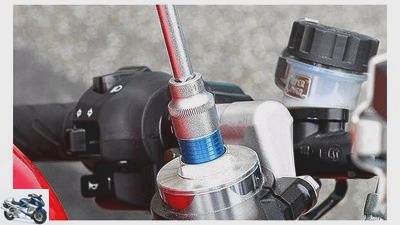
Cook
The spring preload on the telescopic fork is set using threaded spindles (blue here). A socket with a rounded hexagon protects the sensitive, anodized surface.
With the threaded spindle located in the upper fork plug, the preload of the fork springs can be regulated (photo). To do this, both spindles are changed with the same number of revolutions. When turning clockwise, the machine lifts up out of the suspension; when turning in the opposite direction, the front section lowers. The spring preload changes the negative spring travel (rebound travel). In other words, the spring travel that is necessary for rebounding when there are depressions in the road.
Attention: The spring preload does not change the spring stiffness (technical jargon: spring rate), but only the initial position of the spring process (spring base) and the proportions of negative and positive spring deflection.
Effects on driving and suspension behavior:
Insufficient spring preload on the fork:
- The front of the motorcycle is too low, the steering head angle and caster change in the direction of maneuverability and instability.
- The fork can block when braking hard, and the front wheel then tends to lock.
- The motorcycle is wobbly and nervous when cornering.
- Seat height and center of gravity drop.
Checking while standing: Measure the spring deflection as described.
Too much spring preload on the fork:
- The front of the motorcycle is too high, the steering head angle and caster are becoming more difficult to handle.
- The front end can tend to knock the handlebars on undulating stretches because of the insufficient negative spring deflection.
- Motorcycle loses its handiness.
- The seat height and center of gravity increase.
Checking while standing: Measure the spring deflection as described
Basic function of the spring preload: On the shock absorber
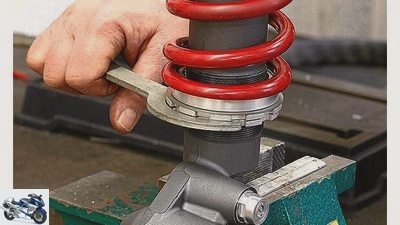
Cook
Poorly accessible struts with deflection systems must be removed to change the preload. Rule of thumb: a ten millimeter change in height at the rear corresponds to five at the shock absorber.
Depending on the design, the spring preload can be set using a ratchet mechanism or two locknuts. In the case of high-priced motorcycles, it can be adjusted using a hydraulic remote adjustment.
By turning the ring nut clockwise, the motorcycle is raised; in the opposite direction of rotation, the rear frame is lowered. In central spring systems, the mechanical transmission ratio between the rear wheel axle and the strut is around two to one. This means that in order to raise the rear frame by 10 mm, the spring must be pretensioned 5 mm more.
The spring preload changes the negative spring travel (rebound travel) and thus the level of the machine. This level has a decisive influence on the driving behavior (handling, stability) and the spring system, respectively the deflection angle of the swing arm (height difference between swing arm axis and wheel axis). This angle must be in a structurally defined area. If the angle is too flat (spring preload too low), the rear can dive down when accelerating due to the dynamic axle load change in interaction with the chain pulling forces, which has a negative effect on handling and cornering stability. If the spring base is too high and the swing arm is too steep, the suspension hardens when you accelerate and the bike can lose contact with the asphalt on bumps.
Effects on driving and suspension behavior:
Insufficient spring preload on the shock absorber:
- The rear of the motorcycle is too low, the steering head angle and caster change in the direction of unwieldiness.
- The shock absorber can block in the event of strong bumps or a high load.
- The motorcycle is unwieldy and stiff when cornering.
- The motorcycle pushes towards the outside of the curve in an inclined position.
- Seat height and center of gravity drop.
Checking while standing: Measure the spring deflection as described.
Too high spring preload:
- The rear of the motorcycle is too high, the steering head angle and caster change in the direction of instability.
- The rear wheel can lose contact with the ground on bumpy stretches.
- Motorcycle can lose cornering and driving stability.
- The seat height and center of gravity increase.
Checking while standing: Measure the spring deflection as described.
Videos: expert tips
Martin Bauer, two-time IDM Superbike champion and managing director of MB Bike Performance, gives tips on adjusting the suspension on a motorcycle:
Related articles
-
Chassis special part 1: motorcycle suspension
fact accesories landing gear & Spring elements Chassis special part 1: motorcycle suspension Chassis special: suspension Everything about motorcycle…
-
Suspension guide – correctly adjusting the damping, part 2
Cook counselor workshop Adjusting suspension / damping correctly, part 2 Guide: correctly adjusting the suspension / damping, part 2 A mystery for many:…
-
Guide: Braking correctly, part 1 – without ABS
jkuenstle.de 9 pictures 1/9 Braking properly without ABS: Your colleague shows you how: knees on the tank, upper body upright, view far ahead. The arms…
-
Suspension special: Part 3 – Strut damping
triumph accesories landing gear & Spring elements Suspension special: Part 3 – Strut damping Suspension special: shock absorber The right set-up for the…
-
Suspension special: Part 7 – rear
archive accesories landing gear & Spring elements Suspension special: Part 7 – rear Suspension special: rear Does the motorcycle drive strange lines?…
-
Swing geometry and suspension behavior
Drawing: MOTORCYCLE motorcycles Swing geometry and suspension behavior Swing geometry and suspension behavior Chain reaction Full steam ahead, the chain…
-
motorcycles Suspension tuning Suspension tuning The right twist If you want to raid the curbs with momentum, you not only have to have yourself fully…
-
accesories landing gear & Spring elements Basic chassis set-up Basic chassis set-up Basic chassis set-up The chassis tuning begins with the inspection of…
-
This is how it works: Adjust the spring base yourself
accesories landing gear & Spring elements This is how it works: Adjust the spring base yourself This is how it works: Adjust the spring base Adjust the…
-
Introduction of chassis tuning
fact 12th pictures Edge 1/12 The strut sits on the right outside of the chassis without any deflection. In the limited edition an Ohlins TTX36. Cook 2/12…